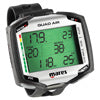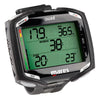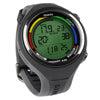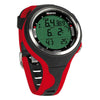Mares makes a wide range of dive computers and has pioneered many new technologies and features in the diving industry. Their range of dive computers including watch, wrist and console style computers in a variety of sizes.
Mares Dive Computers are always easy to use, intuitive and feature a clear and understandable display. They even produce oversized screen models with large digits for divers that have had enough of looking at the tiny displays that can be found on some dive computers.
Mares Dive Computer Comparison
 |
 |
 |
 |
 |
 |
 |
 |
 |
 |
|
| Model | Mares Genius | Mares Quad Air | Mares Quad | Mares Matrix | Mares Puck Pro Plus | Mares Smart Air | Mares Smart | Mares Puck Air | Mares Puck Mission 2 | Mares Puck Mission 3 |
|---|---|---|---|---|---|---|---|---|---|---|
| Mounting Type | Wrist | Wrist | Wrist | Watch Size | Wrist | Watch Size | Watch Size | Console | Console | Console |
| Screen Type - more info | LCD Colour | Segment | Segment | Dot Matrix | Segment | Segment | Segment | Segment / Matrix | Segment | Segment |
| Display Protection - more info | Mineral Glass | Mineral Glass | Mineral Glass | Mineral Glass | Mineral Glass | Mineral Glass | Mineral Glass | Mineral Glass | Mineral Glass | Mineral Glass |
| Backlight | Yes | Yes | Yes | Yes | Yes | Yes | Yes | Yes | Yes | Yes |
| Number of Buttons | 4 | 4 | 4 | 4 | 1 | 2 | 2 | 1 | 1 | 1 |
| Air Integration - more info | Wireless | Wireless | No | No | No | Wireless | No | Hose | No | No |
| Compass | Digital | No | No | Digital | No | No | No | No | No | Analogue |
| Nitrox Compatible | Yes | Yes | Yes | Yes | Yes | Yes | Yes | Yes | Yes | Yes |
| Trimix Compatible | Yes | No | No | No | No | No | No | No | No | No |
| Gas Switching - more info | 5 Gas Mixes | 3 Gas Mixes | 3 Gas Mixes | 3 Gas Mixes | No | 2 Gas Mixes | 2 Gas Mixes | No | No | No |
| Interface Compatible - more info | Bluetooth | Optional Cable or Bluetooth | Optional Cable | Cable | Optional Cable | Optional Cable or Bluetooth | Optional Cable | Optional Cable | Optional Cable | Optional Cable |
| Battery | Rechargeable | User Changeable | User Changeable | Rechargeable | User Changeable | User Changeable | User Changeable | User Changeable | User Changeable | User Changeable |
Mares Dive Computer Technology
Find out more about some of the technologies used within Mares Dive Computers and get to grips with some of the terminology used when talking about dive computers in general.
Mares use a number of screen types across their dive computer range with the most commonly used being LCD technology in either segment or dot matrix configurations.
LCD segment displays are the most cost effective form of display and can actually provide the easiest format to read if the screen is only showing numbers but they aren't so good at displaying words (think back to trying to replicate words on a calculator screen. Segment displays are used in their larger screen models for an even easier to read display
An LCD dot matrix display is the next step up by dividing up the display into much smaller blocks that can be turned on and off to reproduce legible words or instructions.
Mares was one of the first brands to use a colour LCD TFT screen in their Icon HD dive computer which was the technological predecessor to the modern OLED screens. Think of it like a modern smartphone compared to the old blocky screens of a 15-20 year old mobile phone. The advances in information display is massive!
The latest in screen technology is the OLED screen which are energy efficient, bright and full colour but are expensive so they are typically only found in flagship dive computers. Mares currently does not offer an OLED dive computer.
The displays themselves are pretty fragile and not watertight or pressure resistant so they need to be protected by an outer layer which works with the rest of the dive computer housing provide pressure resistance. There are a few different types of glass used in dive computers that offer varying degrees of scratch resistance at varying costs.
Mineral Glass is a cost effective material that has a ranking of 5 on something called the Mohs Scale which is a measure of hardness from 0 to 10. It is pretty tough but something like a stainless steel knife would scratch it. Mares typically uses mineral glass.
The next step up within the diving industry is the use of Sapphire (also know as Corundum) Glass which ranks at 9 out of 10 (Diamond is ranked at 10) and offers much better resistance to scratches but can still be damaged.
We ALWAYS recommend getting a screen guard / display shield for your dive computer regardless of what protects your display. Diving is a fairly unforgiving activity and guaranteed something will happen that will scratch it so a few extra pounds for a new shield is better than hundreds to fit a new screen.
Air integration allows your dive computer to display your cylinder pressure live on the screen for a complete at a glance overview of your essential dive information. On top of this most dive computers will use the current cylinder pressure along with breathing rate data and depth to calculate useful information such as air time remaining.
Air integration is via either a hose connection for a console format dive computer or by using a wireless transmitter which connects directly to the first stage of your regulator and transmits data to a receiver built into the dive computer.
One of the problems we experience as divers is the absorption of nitrogen during a dive which then has to be released during our ascent. With the appropriate training and equipment a diver can use different gas mixes to accelerate the safe release of the nitrogen by 'switching' between the gases at certain points for set amounts of time during the ascent.
Dive Computers collect a lot of data during your dive that some computers are capable of displaying on screen in a meaningful way but to get the most out of the data it needs to be downloaded to a most advantage computer. Most dive computers (with the exception of some entry level models) allow to the data to be downloaded and displayed within a dive management software specific to the brand of computer. The software can show detailed dive profiles, any alerts or alarms that were triggered, breathing rates for air integrated dive computers etc and store it all as a digital dive log.
A big advantage of opting for an interface compatible dive computer quite often the dive management software, including Mares, allows the dive computer firmware to be updated at home should a new version be released, eliminating the need to take the computer into a dealer for upgrade.
Interfacing between the dive computer and your home computer is typically via a special cable like Mares use but other methods have been used in the past such as InfraRed or, now that smart devices are so popular, by using Bluetooth.




